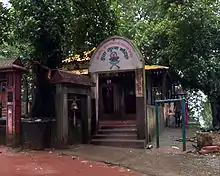Budha Subba Temple
Budha Subba Temple (Manghim) or Budha Subba (Nepali: बुढा सुब्बा) is a famous religious shrine of the eastern people of Nepal which is located at Bijayapur of Dharan, Nepal. The site is located on the top of the Seuti river bank, to small distance east of the Dantakali Temple. It is taken as an important place for religious people. Within the temple, two earthen piles have been raised which have the tradition of worshiping as the Budha Subba. The place has uniquely tip-less bamboo plants. The tips of these bamboos are believed to be broken by shots of slingshot used by Budha subba.Regarded by many as one of the , if not "The Most important cultural site of Eastern Nepal." The temple is crowded by people in Saturdays. Generally at Saturdays, sacrifices of rooster and pigs are made.[1][2][3][4] The temple is systematically handled since 2015 BS (1958-59 CE).[3]
| Budha Subba Temple | |
|---|---|
बुढा सुब्बा | |
 Budha Subba Temple ( Manghim) | |
| Religion | |
| Affiliation | Hinduism |
| District | Sunsari District |
| Location | |
| Location | Dharan - 14 |
| Country | Nepal |
 Location in Nepal | |
| Geographic coordinates | 26.820°N 87.30°E |

Historian Iman Singh Chemjong Limbu says Bijaypur was the capital of the Limbuwan (Pallo Kirat) kingdom during and after the reign of King Bijaynarayan Raya Khebang.[5]
Location
Budha Subba Temple is located in Dharan about 136 mi (or 220 km) east of country's capital city.[6] The site is located on the top of the seuti river bank, to small distance east of the Dantakali temple.
Origin
Myth
According to myth, a Subba hunter Budha Subba and his sister used to play and hunt on the hill with a slingshot. By hitting the tips of a bamboo tree while hunting crow, the tip of the bamboo tree was lost and never grew back. After the miss, Subba gave up hunting, buried his slingshot and started meditation. It is the same spot where the temple stands today and the small mound of mud is believed to be the spot where he meditated. According to this legend, the temple got its name from the hunter. His sister has a temple by its side. Interestingly even today, the bamboo trees in Bijaypur hill do not have a tips and not a single crow could be found in the area, despite the occasional picnickers and the offerings in the temple.[5][7][8][9]
HISTORY
According to the History it is the tomb of the last Limbu King (Rai) of Limbuwan (Pallo kirat), He was tricked into coming to Bijaypur-Dharan for a negotiation, then killed by the assassins of King Prithvi Narayan Shah of the Kingdom of Nepal in 1773. Budhhi Karna Khebang's soul is believed to have wandered around the area of his tomb around Bijaypur and was said to be a friendly and helpful spirit. Then local Limbu people started worshiping the soul as an old king ( Haang means King in Limbu language) believing it to bring good luck.
Lord Shiva/ Parvati
Some say Lord Shiva and Goddess Parvati under the guise of Theba Sammang and Yuma Sammang, Yakthung King and Queen in the process of hunting arrived at Vijaypur where they stuck their bows and sat in a penance. During then, they realized the approach of Kali Yuga and immediately disappeared. That event is called Budha subba in Yakthung language. From the bows sprouted bamboo shoots without the tuft.[10]
Eklavya
Another myth mentions the event of Ekalavya in deep meditation and self training of archery by setting up an image of Guru Dronacharya, famous teacher of Kauravas and Pandavas. It says Ekalavya himself is Budha subba. Worship and meditation at this place are believed to fulfill one's wishes.[3][10]
Bamboo writings and threads
In the vicinity of the temple, initially there was a trend of writing on the bamboo tree. The young men who came to visit the temple would return only by writing a name on bamboo as it is believed that writing the name of lovers will give success in their love. But, the temple committee has stopped the name writings on the bamboo as the name writings of the bamboo hampered the growth of the bamboo with the increase in bamboo writings. Nowadays, lovers tie sacred threads to the bamboo after worshiping Budha subba.[2][7][9]
Translation:
will go to budha subba to write on bamboo trees today!
how long should I stay thinking that you will come...[11]
References
- "Budha Subba Temple 2019, #2 top things to do in dharan, eastern development region, reviews, best time to visit, photo gallery | HelloTravel Nepal". www.hellotravel.com. Retrieved 2019-07-29.
- "Budha Subba Temple – Dharan, Bijayapur – Nepali Movies, films". Retrieved 2019-07-29.
- घिमिरे, अशोक. "बुढासुब्बा मन्दिरको गाथा". gorkhapatraonline.com.
- काफ्ले, योगेशबाबु. "कसम बुढासुब्बा,भाले चढाउँछु !". blastkhabar.com.
- "Beloved Bamboos of Budha Subba in Bijaypur (Dharan)". Wagle Street Journal (in Nepali). 2010-09-21. Retrieved 2019-07-29.
- Unknown (2017-05-16). "Yakthung: Budha Subba Temple". Yakthung. Retrieved 2019-07-29.
- "A Place for Pilgrimage and True Love". Boss Nepal. Retrieved 2019-07-29.
- मल्ल, कृष्ण. "गन्तव्य बुढासुब्बा-धागो बाँध्दै रमाउँदै". healthpostnepal.com. Retrieved July 29, 2019.
- खबर, अनलाइन. "नाम बुढासुब्बा, काम जवानको डेटिङ !". onlinekhabar.com.
- "Budhasubba". Nature Trail Travels & Tours, Trekking & Expeditions. Retrieved 2019-07-29.
- "Guransa ko phed muni". www.nepalisongchord.com. Retrieved 2019-07-29.